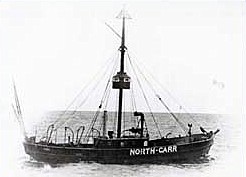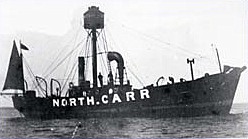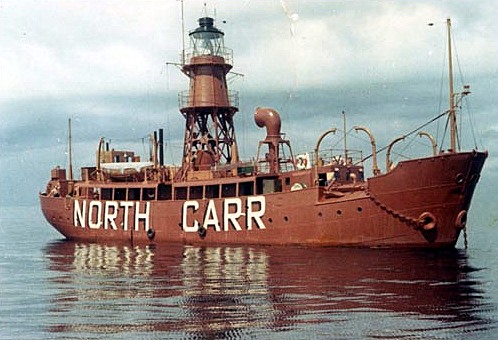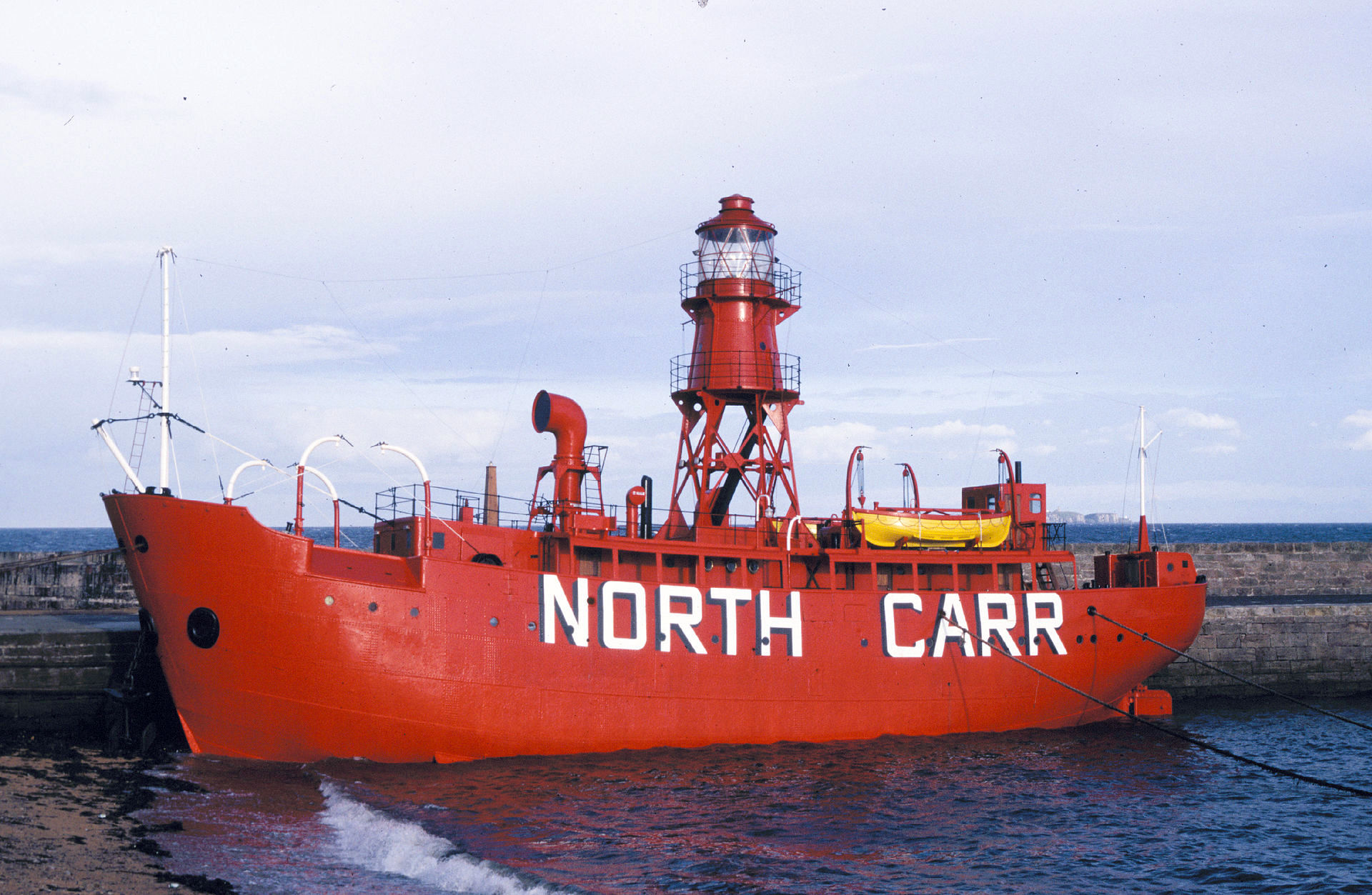
The North Carr Rock
The North Carr Rock is a dangerous rock, situated on the turning point of vessels entering the Firth of Forth coming from the north, but also dangerous for vessels from the south to the Firth of Tay. Before the rock had been marked, it was responsible for numerous casualties by the sinking of ships.
While Robert Stevenson was building the nearby Bell Rock lighthouse, he had noted the loss of sixteen ships between 1800 and 1809 on the treacherous North Carr Reef. It proved impossible to build a lighthouse on this reef and the Northern Lighthouse Board decided to replace the floating buoy at Carr Rock with a tide-operated clock tower built from Fife sandstone. However, its construction was unsuccessful and at least a cast iron beacon was chosen which was finally completed in September 1821.
By questions of the vessel masters and Officers, the Dundee Harbour Trustees, and others, consideration was given to marking the rocks by means of a lighthouse at Fife Ness. The thought to establish a light on the North Carr Rock was abandoned fast, because the expense was very high for laying a suitable foundation on the friable rocks of North Carr.
The preference was to given for a Lightvessel to be placed on 1 NM (~ 1.8 km) due east of the Carr Rock, approximately 10,5 NM (~ 19 km) from the Bell Rock and 7 NM (~ 13 km) from the Isle of May. This also immediately eliminated the need to improve the lighthouse light on the Isle of May.
The North Carr Rock has had three different lightvessels in succession;
✔ 1st from 1887 to 1889
✔ 2nd from 1889 to 1933
✔ 3rd from 1933 to 1975
The first North Carr Lightvessel(I) - (1887 - 1889)
The first lightvessel to be stationed off the North Carr rock was timber-built with copper fastenings. She came on loan from Trinity House, and was brought north by tug from Blackwell, near London. She measured about 30 meters long and just over 6.5 meters across the beam, and was brought to his position on June 7th June 1887. Her position was given about 1 nautical mile off the North Carr beacon, and was stationed in 40 meters (22 fathoms) depth of water. As a result, there was no longer need for the low light on the island of May which 7 nautical miles away, so this low light was permanently discontinued.
The light, designed by the Stevensons, was 2.4 meter in diameter and was made up of 8 independent lamps, mounted on gimbals, and used vegetable-based colza oil, as illuminant. It was a fixed white light and visible to about 11 nautical miles. Two 6 horse power engines powered the fog horn.
The crew of the lightvessel consisted of a master, mate and nine seamen, of whom one officer and six seamen were always on board. The Master received £115.10.7d per annum with uniform; the Mate £97.0.7d per annum with uniform and the seamen £69.6.8d per annum with uniform. It was a condition of their employment that the officers and crew resided in Crail, and when ashore occupy themselves to the workshop/storage, which had been built there for coke, provisions etc.
The coke which was delivered to the Crail storage was required to drive the fog signal machinery on the Lightvessel. The officer and three crew members ashore were also required to man the Attending Boat, which sailed weekly for the Isle of May and fortnightly to the North Carr.
The original Attending Boat had been replaced on 6 June 1888 by the Steam Launch "May" - built by Messrs Hawthorn & Co Ltd, Leith for £510 for which a special berth had been obtained in Crail. On transfer to Granton she continued in operation until May 1899 when she was sold for £150. The SS " May" took over with the officer and crew on shore from the Lightvessel forming part of the crew when she made ordinary gas, buoy and relief work. The officers alternately acted as Mate of the "May" for which they received an extra 1/- per day all the year round. In 1902, when the Bell Rock light was being altered, these duties were increased to include all necessary trips to the Rock.The second North Carr Lightvessel(II) - (1889 - 1933)
After lightvessel(I) the Trinity House vessel was replaced, two years later, by one purpose ship built for the Northern Lighthouse Board by Alex Stephen & Son of Dundee. This firm was chosen because of their experience in building strong wooden vessels for the whaling industry.
These second North Carr lightvessel is also of wood. According to the "East of Fife Record" of 5th April 1889: "The new lightvessel is 32 meters in length, 7 meters in breadth, had a draft of 3.5 meters and had tonnage of 255. She was built exceptionally stronger, more beyond the highest class of Lloyd's requirements for such vessels; and indeed it may be said that she is fortified equal to the Dundee whaling fleet. The frame are of oak and the planking of teak, with the exception of the bottom planks, which are of English elm, while the fastenings are all of pure copper. The hull was sheathed in copper for protection from vessel worm. The lantern and its mechanism weighed 4 tons.
On the ship was accommodation for a crew of 6 seaman and the captain's cabin, that is fitted up in superior style. Two extra berths were provided in the cabin, because it may happen that the engineers or others whom are visiting the vessel, due to bad weather or a storm, were unable to leave the ship for some time. The lightvessel was launched in Dundee on 2nd April 1889, and then moved to Hawthorne's of Leith for fitting out with machinery. She was towed out to the North Carr rocks on 27th July 1889.
Although the ship was equipped with a light, David A. Stevenson, on a complaint in 1895 about the difficulty of distinguishing a clear white light, noted: "The North Carr ship is essentially a fog signal ship, not a light ship, because the light is more to avoid hitting the ship itself." The wooden vessel (then sold to Mr H Hinks, Appledore, North Devon for £275) was replaced on 3 April 1933 by the third lightship at Carr Rock.The third North Carr Lightvessel (III) - (1933 - 1975)
The third and final North Carr lightvessel for the Northern Lighthouse Board was built in Glasgow by A. & J. Inglis at a cost of £15,430. The characteristics of this third ship are: Length 31 meters, beam 7.5 meters and gross tonnage of 250. She is built of metal and needed overhauling every three years. This lightvessel had no motive power of her own, so had to be towed whenever she was required to move.
This means, of course, more space available for the generators and other installations to do the job. The engine-room, for instance, is given over to three Diesel Generators and three Diesel Air-Compressors together with large fuel storage tanks and containers for compressed air - all catering for the requirements of the light and fog signal. The chain locker is another distinctive department, housing two spare cables. The anchor weighs 3 tons and also two spare anchors were carried.
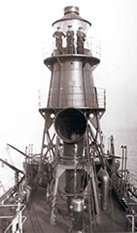
The building of this ship caused quite a stir in Edinburgh when the fog horn was tested. The lightvessel was lying at a point 900 meters outside Granton in the Firth of Forth. As the fog horn had a range of approximately 10 nautical miles( ~18 km), north Edinburgh could hear it loud and clear and the complaints to the builders, By the newspapers and from the police were numerous - particularly as it was being sounded in clear weather. "Hundreds of city dwellers have had no sleep over three consecutive nights". Her hull and superstructure are painted red and the name North Carr is painted on both sides of the hull
The fog horn, with two blasts every minute and a half, could be aimed in any direction and was very similar in design to the examples used on land. But because of the use at sea, weather influences from the sea had to be taken into account. The remedy that had been applied for this was the use of steam that prevented fouling. Sea-life also presents another kind of difficulty, for limpets and barnacles take up residence in prolific number on the vessel's bottom. To deal with this as far as they can, the crew make use of an elephantine back-scraper, like an out-size garden hoe. But even in spite of these exertions, about six tons of barnacles have to be dislodged when the vessel comes into port for her periodic overhauls.
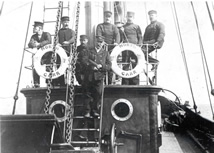
Up on the deck, the dominating feature was the lighthouse dome, surmounted by a lightning conductor 12 meters above the sea. At the start of the lightvessel (3 April 1933), a fixed white light was shown. But later from sunset to sunrise, the light was changed to two flashes in quick succession every half minute. The light was visible for over ten nautical miles. The source is a 1,000 watt electric bulb, magnified by the usual prismatic lenses which are rotated around by a small electric motor.
The only regular visitor is the lighthouse tender from Granton, which arrives every fortnight with mail, stores, rations, newspapers and reliefs. The lightvessel crew consisted of eleven men; one senior master, one assistant master, three senior enginemen, three assistant enginemen and three seamen. Of this crew one master, two senior enginemen, two assistant enginemen and two seamen were all on board at the same time. The two masters spent alternatively two weeks on the ship and two weeks ashore and the other members of the crew were in rotation, a month on the vessel afloat with two weeks ashore.
During the Second World War (1939-45), when all lights were extinguished, except when needed by the subtitle, the North Carr lightvessel was moved to a place between the Mull of Kintyre and the Mull of Galloway. To helping mark the entrance to the Firth of Clyde.
The lightvessel was eventually acquired by the then North East Fife District Council and for a time became a floating museum at Anstruther. It now lies in Dundee Harbour awaiting long-overdue restoration.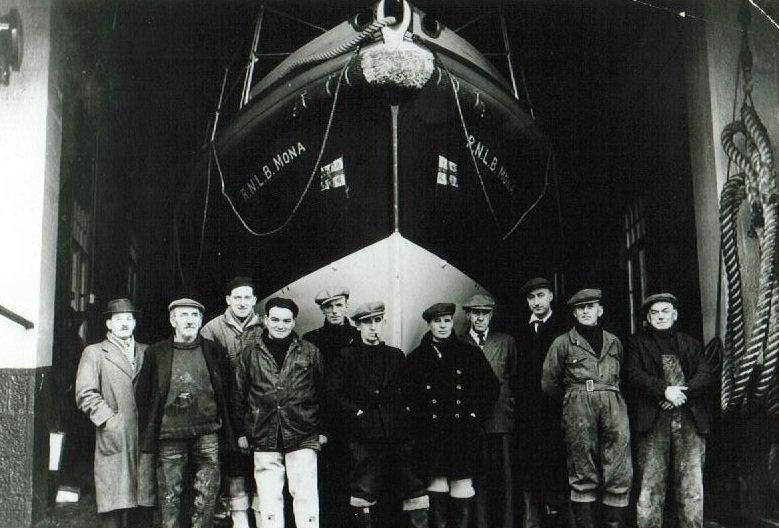
The December Gale 1959
In December 1959 the coast of Scotland was battered by one of the worst gales for years. On the 8th the Lightvessel broke from her moorings and the Broughty Ferry Lifeboat, Mona, which went to her assistance, capsized and was lost with all of the seaman. The Lightvessel managed to anchor about 300 meters off the rocky shore at Kingsbarns, near St Andrews and the crew was taken off by two Bristol Sycamore helicopters from Leuchars on 9 December, after an attempt to tow the Lightvessel, had failed.
The rescue was made in extremely adverse conditions. A full gale was blowing and the Lightvessel was rolling and pitching heavily. To assist in the rescue operations the crew cut away the 12-meter-high mast, which allowed the helicopters to fly as low as 1,5 meters above the lantern and pick up members of the crew from the lightroom roof. The Lightvessel was eventually taken in tow by the Admiralty tug "Earner" on 11 December, repaired at Leith and put back on station on 16 March 1960.



 Update: 01-03-2025
Update: 01-03-2025
